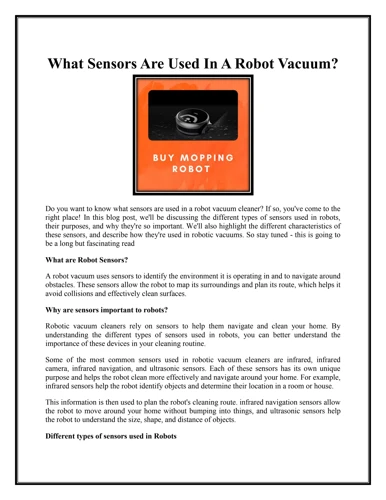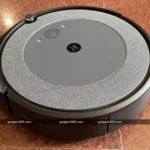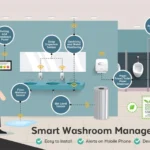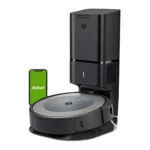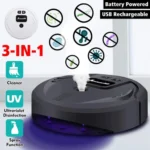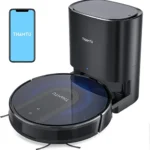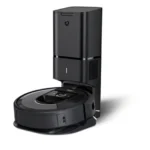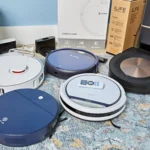As we move towards a more automated lifestyle, smart and efficient household appliances have become a necessity. One such appliance that has become increasingly popular is the smart vacuum cleaner. The advancement of sensor technology has played a huge role in the evolution of vacuum cleaners, making them more intelligent and efficient than ever before. With a range of sensors at their disposal, smart vacuum cleaners are able to navigate through obstacles, detect dirt and debris, and effectively clean floors. In this article, we will explore the various types of sensors used in smart vacuum cleaners, their functions, and how they work together to create an efficient cleaning experience.
Common Types of Sensors in Smart Vacuum Cleaners
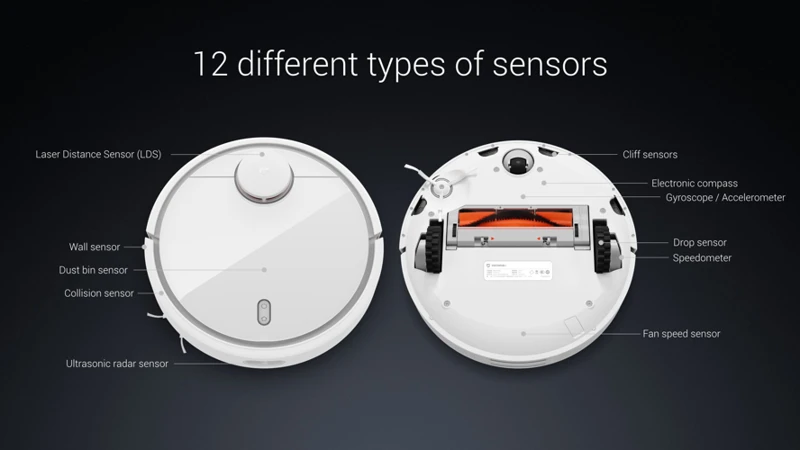
Smart vacuum cleaners have revolutionized the way we keep our homes clean. These devices are equipped with a variety of sensors that allow them to navigate around objects, detect obstacles, and even map out the layout of a room. Some of the most common types of sensors used in smart vacuum cleaners include infrared sensors, ultrasonic sensors, optical sensors, tactile bump sensors, cliff and obstacle sensors, camera sensors, mapping sensors, acoustic sensors, and accelerometers and gyroscopes. These sensors play a crucial role in enabling the vacuum cleaner to move around a room smoothly and efficiently while avoiding any potential hazards. In the following sections, we will dive deeper into each of these types of smart vacuum sensors and explore how they are used.
Infrared Sensors
One of the most common types of sensors used in smart vacuum cleaners are infrared sensors. These sensors emit infrared light, which is then reflected off of surfaces and returned to the sensor. Based on the amount of time it takes for the light to be returned, the sensor can determine the distance to the object.
In the table below, we have highlighted some key features and uses of infrared sensors in smart vacuums:
| Features | Uses |
|---|---|
| Uses infrared light to measure distance | Obstacle detection and avoidance |
| Can detect objects up to several feet away | Prevents collisions with furniture and walls |
| Works well in low light conditions | Allows for cleaning in dimly lit areas |
| Can be combined with other sensor types for improved accuracy | Enhanced navigation and mapping |
Infrared sensors are commonly used for obstacle detection and avoidance. They allow the vacuum cleaner to sense when it is getting too close to a wall or piece of furniture, and adjust its path accordingly. This not only prevents damage to the vacuum cleaner and furniture, but also ensures a thorough cleaning.
These sensors can be useful for cleaning in low light conditions. While some smart vacuums have cameras or other types of sensors for visual recognition, infrared sensors can detect objects in the dark without the need for additional lighting.
Infrared sensors can be used in combination with other sensors to improve navigation and mapping. For example, combining infrared sensors with optical or mapping sensors can help the vacuum cleaner create a more accurate map of the room and avoid obstacles more efficiently.
Infrared sensors are an essential component of smart vacuums. They are versatile, reliable, and effective at obstacle detection and avoidance. If you want to learn more about other types of smart vacuum sensors, check out our article on smart vacuum sensors. If you want to know how these sensors improve the cleaning efficiency of smart vacuums, read our article on smart sensors for cleaning efficiency.
Ultrasonic Sensors
Ultrasonic sensors are another common type of sensor used in smart vacuum cleaners. These sensors work by emitting high-frequency sound waves that bounce off of objects in a room, allowing the vacuum cleaner to detect their distance and location.
Here are some key features of ultrasonic sensors:
- Ultrasonic sensors are able to detect objects even in low light environments, making them useful for cleaning in dimly lit areas such as under furniture or in corners.
- These sensors are also able to detect clear and transparent objects, which may be difficult for other types of sensors to detect.
- Ultrasonic sensors can be used in conjunction with other sensors for more accurate object detection and navigation.
- They can also be used to detect obstacles and adjust the vacuum cleaner’s path accordingly, helping to prevent collisions and damage to furniture.
Ultrasonic sensors are particularly useful for smart vacuum cleaners that prioritize efficiency and precision in their cleaning abilities. These sensors can help the vacuum cleaner to clean faster and more effectively, and can also help to prevent damage to furniture and other objects in the room.
As technology advances, we may see even more advanced uses for ultrasonic sensors in smart vacuum cleaners. For example, these sensors could potentially be used in combination with indoor mapping sensors to create more detailed and accurate maps of a room’s layout, helping the vacuum cleaner to navigate even more efficiently.
If you want to know more about smart sensors and obstacle detection used in vacuum cleaners, check out our article on smart sensors for obstacle detection.
Optical Sensors
Optical sensors are used in smart vacuum cleaners for navigation and mapping purposes. These sensors use optical signals to determine the location of the vacuum cleaner within a room.
There are two main types of optical sensors used in smart vacuum cleaners: time-of-flight (ToF) sensors and laser-based sensors. ToF sensors work by emitting a light signal and measuring the time it takes for the signal to bounce back to the sensor. Laser-based sensors use a laser light to scan the environment and create a 360-degree map of the surroundings.
ToF sensors are commonly used in smart vacuum cleaners because they are small and require less power than laser-based sensors. They are also less expensive, making them a popular choice for entry-level models. ToF sensors can detect objects in front of the vacuum cleaner and adjust the cleaning path accordingly, making the cleaning process more efficient.
Laser-based sensors, also known as Light Detection and Ranging (LiDAR) sensors, are more accurate than ToF sensors and can create a more detailed map of the environment. They are commonly used in high-end smart vacuum cleaners that are designed for larger homes or commercial spaces. With LiDAR sensors, smart vacuum cleaners can create a detailed map of a room and navigate around obstacles with ease.
One of the main advantages of optical sensors is that they can be used to create a 3D map of a room. This allows the vacuum cleaner to clean in straight lines rather than randomly bumping into objects. Additionally, optical sensors can detect the height of furniture and other objects, enabling the vacuum cleaner to clean under and around them.
Optical sensors are an essential component of smart vacuum cleaners. Whether they are using ToF sensors or laser-based sensors, optical sensors allow vacuum cleaners to navigate and map their surroundings, making the cleaning process more efficient and effective. For more information on other types of smart sensors used in vacuum cleaners, check out our article on smart sensors for indoor mapping, smart sensors for carpet cleaning, and smart sensors for noise reduction in vacuum cleaners.
Tactile Bump Sensors
Tactile bump sensors are another type of sensor found in smart vacuum cleaners. These sensors are also commonly referred to as “touch sensors” and play a vital role in helping the vacuum cleaner detect and avoid obstacles as it navigates around a room.
Unlike other sensors that rely on remote detection methods, tactile bump sensors use physical contact with their surroundings to gather information. They are usually located on the front of the vacuum cleaner and consist of soft yet durable material that can absorb impacts.
How Tactile Bump Sensors Work
When the vacuum cleaner comes into contact with an object or obstacle, the tactile bump sensors detect the change and send a signal to the vacuum’s control system. This signal then triggers the vacuum cleaner to change its direction or stop moving altogether.
Tactile bump sensors work well for detecting objects that are at a low height, such as chair legs, coffee tables, or baseboards. They are ideal for working in conjunction with other types of sensors to give the vacuum cleaner a comprehensive view of its surroundings.
The Advantages of Tactile Bump Sensors
One of the biggest advantages of tactile bump sensors is their low cost in comparison to other sensor types. Tactile bump sensors are relatively cheap to produce, and they don’t require a lot of processing power to function, making them an attractive option for manufacturers.
Another advantage is their ability to detect obstacles that are not within the range of other sensors, such as low-lying objects. Tactile bump sensors can also identify objects that have a curved or uneven surface, which could be easily missed by other sensor types.
However, one of the limitations of tactile bump sensors is that they require close proximity to an object to detect it. This means that the vacuum cleaner may still collide with an object at fast speeds, regardless of whether it has a tactile bump sensor or not.
To summarise, tactile bump sensors are an essential component of smart vacuum cleaners, working in tandem with other sensor types to help the vacuum cleaner navigate around the room and avoid obstacles effectively. Despite their limitations, tactile bump sensors provide an economical and reliable solution for detecting and avoiding obstacles within its range.
Table: Comparison between Tactile Bump Sensors and Other Sensor Types
| Sensor Type | Cost | Range | Shape Detection | Proximity to Object |
|---|---|---|---|---|
| Tactile Bump Sensors | Low | Close proximity | Curved/uneven surfaces | Required |
| Infrared Sensors | Medium | Long-range | No | Not required |
| Ultrasonic Sensors | Medium | Medium-range | No | Not required |
| Optical Sensors | High | Short-range | Yes | Not required |
Cliff and Obstacle Sensors
Navigating around the house can be tricky for vacuum cleaners, especially when they come across cliffs, stairs or obstacles. That’s where cliff and obstacle sensors come in handy. These sensors detect drops or obstacles in the cleaner’s path and signal the vacuum to stop and adjust the direction.
Here are some types of cliff and obstacle sensors:
- Infrared cliff sensors: These sensors detect a drop or cliff by emitting a beam of infrared light and measuring how much light is reflected back. If there is no reflection, the vacuum concludes that it is about to plummet and halts its movement.
- Ultrasonic obstacle sensors: These sensors use high-frequency sound waves to detect nearby obstacles. The vacuum cleaner then adjusts its direction or slows down to avoid hitting them.
- Optical obstacle sensors: This type of sensor relies on cameras to detect obstacles. The cleaner’s software analyzes the images captured by the camera to determine whether there are any potential obstacles in its path.
- Tactile bump sensors: These sensors are activated when the vacuum cleaner bumps into an object. They help the cleaner to determine whether the object is a fixed obstacle or a movable object that should be sucked up.
Thanks to these sensors, vacuum cleaners can navigate around obstacles and steep drops without causing damage to itself or the surroundings. Obstacle and cliff sensors prevent unnecessary damage from happening and make cleaning much easier for the user.
Camera Sensors
One of the most advanced sensor technologies used in smart vacuum cleaners is camera sensors. These sensors incorporate one or more cameras that allow the vacuum cleaner to see its surroundings and make intelligent decisions based on what it “sees”.
Camera sensors can be used to create a map of the room or floor that the vacuum cleaner is operating in, which is useful for both navigation and cleaning efficiency. Additionally, cameras can be used to identify objects in the room, such as furniture or other obstacles, and avoid them as the vacuum cleaner moves around.
Camera sensors are also useful for identifying areas that are particularly dirty, so the vacuum cleaner can spend more time cleaning those specific areas. Some advanced vacuum cleaners even use computer vision algorithms to identify different types of debris, such as pet hair or dirt, and adjust their cleaning patterns accordingly.
Here is a table summarizing the key advantages and disadvantages of camera sensors in smart vacuum cleaners:
| Advantages | Disadvantages |
|---|---|
| Can create a detailed map of the room/floor | Require significant computation power |
| Can identify obstacles and avoid them | May be obstructed by low furniture or other items |
| Can identify areas that need extra cleaning | Can be expensive to implement |
| Can identify different types of debris and adjust cleaning accordingly | May not work well in low light conditions |
Camera sensors are a promising technology that offer several advantages for smart vacuum cleaners. While they do have some limitations, their ability to create a visual map of the room and identify obstacles and areas that need extra cleaning make them a valuable addition to any vacuum cleaner’s sensor suite.
Mapping Sensors
Smart vacuum cleaners use mapping sensors to create maps of the rooms they clean. These sensors are essential in helping the vacuum cleaner navigate through the room, identify obstacles, and plan the most efficient cleaning route. There are two common types of mapping sensors used in smart vacuum cleaners: laser sensors and camera sensors.
Laser Sensors: Also known as Lidar (Light Detection and Ranging) sensors, laser sensors use laser beams to scan the room and create a 2D or 3D map of the area. These sensors emit laser beams and measure the time it takes for the beams to bounce back from the objects in the room. The data collected is then used to create a map of the room, which the vacuum cleaner can then use to navigate. The advantage of Lidar sensors is that they can work in low light conditions and can map a room quickly and accurately.
Camera Sensors: Camera sensors take pictures of the room and use computer vision algorithms to create a map of the area. These sensors use a combination of software and hardware to interpret the images and create a map of the room. This type of mapping sensor is not as common as laser sensors but is gaining popularity due to its ability to create more accurate and detailed maps.
Here is a comparison table of the two types of mapping sensors used in smart vacuum cleaners:
| Mapping Sensor Type | Advantages | Disadvantages |
|---|---|---|
| Laser Sensors | Can work in low light conditions, Can map a room quickly and accurately | Expensive, Can be affected by obstacles that it cannot see |
| Camera Sensors | Create more accurate and detailed maps, Can identify specific objects and features | Requires more processing power, May not work well in low light conditions |
Mapping sensors are an important component of smart vacuum cleaners. They help the vacuum cleaner navigate through the room and clean more efficiently. By using multiple mapping sensors, smart vacuum cleaners can create accurate and detailed maps of the room, which helps them clean around obstacles and in tight spaces.
Acoustic Sensors
Acoustic sensors are another type of sensor commonly found in smart vacuum cleaners. These sensors use sound waves to detect the distance of objects and the size of rooms, assisting the vacuum cleaner in mapping its environment and navigating around obstacles.
Advantages: Acoustic sensors are effective at detecting soft and hard surfaces, which makes them suitable for use in different types of flooring such as carpets and tiles. They also register low noise levels, making them ideal for use in homes where noise might be an issue.
Limitations: One potential limitation of acoustic sensors is that they are not very precise at detecting very small obstacles. Additionally, because they rely on sound waves, they can sometimes be thrown off by background noise or interference.
Examples: One popular example of a smart vacuum cleaner that utilizes acoustic sensors is the iRobot Roomba. The Roomba’s acoustic sensors work in conjunction with its other sensors to effectively navigate and clean a room.
Below is a table summarizing the key features and limitations of acoustic sensors in smart vacuum cleaners:
| Feature | Advantages | Limitations |
|---|---|---|
| Uses sound waves to detect distance and size | Effective at detecting soft and hard surfaces, suitable for different types of flooring | Not precise at detecting very small obstacles, can be thrown off by background noise or interference |
| Works well in conjunction with other types of sensors | Enhances overall performance of the vacuum cleaner | Can be expensive to incorporate into the vacuum cleaner |
| Low noise levels | Ideal for use in homes where noise might be an issue |
Although acoustic sensors have some limitations, their ability to complement other types of sensors and provide valuable information about a room’s layout and surface types make them an important component of many smart vacuum cleaners.
Accelerometers and Gyroscopes
Smart vacuum cleaners use a variety of sensors to navigate and clean efficiently. One of the most important types of sensors used in these devices are accelerometers and gyroscopes.
Accelerometers are sensors that measure acceleration in three dimensions, allowing the vacuum cleaner to understand its movements as well as speeds and directions of movement. This type of sensor is essential to help vacuum cleaners navigate around furniture or narrow spaces.
Gyroscopes, on the other hand, are sensors that measure the orientation and angular rate of the vacuum cleaner. These sensors are useful for detecting the vacuum cleaner’s position in relation to the ground, which helps to improve its stability and balance, while also ensuring that it doesn’t fall over or get stuck in one place. For example, if the vacuum cleaner accidentally rotates or tips over, the gyroscope will detect this and alert the device, making it easier to prevent accidents.
Here is a table summarizing the differences between accelerometers and gyroscopes:
| Accelerometers | Gyroscopes |
|---|---|
| Measure acceleration in three dimensions (x, y, z) | Measure orientation and angular rate |
| Help vacuum cleaners navigate around obstacles | Ensure vacuum cleaners remain stable and balanced |
| Useful for detecting changes in speed and direction of movement | Useful for detecting changes in orientation and positioning |
Having multiple types of sensors like accelerometers and gyroscopes in smart vacuum cleaners can help improve their efficiency and accuracy. These sensors allow the vacuum cleaner to detect and navigate around obstacles, ensure that it remains stable and balanced, and accurately measure its speed and direction of movement. These sensors can prevent accidents by detecting when the vacuum cleaner is not in the proper position or orientation.
Accelerometers and gyroscopes are essential sensors used in smart vacuum cleaners because they help these devices better navigate and clean efficiently. Using these sensors together helps maintain the device’s balance, provides accurate measurements for speed and direction of movement, and prevents unwanted accidents.
How Vacuum Cleaners Use Sensors to Navigate and Clean
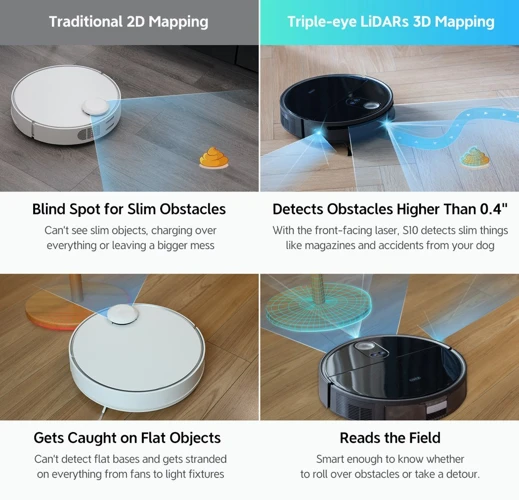
Have you ever wondered how smart vacuum cleaners navigate and clean your floors with such precision? The answer lies in the advanced sensors that these devices use. By using a combination of sensors for navigation, object detection, cleaning effectiveness, and battery management, these machines are able to efficiently detect and remove dirt and debris from your home. Let’s explore how these sensors work together to make your cleaning experience as hassle-free as possible.
Sensors for Navigation
Smart vacuum cleaners come equipped with a range of sensors that play important roles in their navigation and cleaning abilities. One of the most crucial types of sensors are those used for navigation. These sensors help the vacuum cleaners to map and navigate the space they are cleaning.
Some common sensors for navigation in smart vacuum cleaners include:
| Sensor Type | Description |
|---|---|
| Infrared Sensors | These sensors emit infrared beams to detect objects and calculate distances. They help the vacuum cleaner to avoid colliding with objects in its path. |
| Ultrasonic Sensors | These sensors emit high frequency sound waves and then uses the reflections to create a map of the space. They help the vacuum cleaner to detect obstacles, walls, and furniture. |
| Optical Sensors | These sensors rely on optical detection to map the room. They use a camera and infrared lights to detect obstacles and furniture during cleaning. |
| Mapping Sensors | These sensors create a map of the room by detecting and analyzing features in the environment, such as corners or walls. They help the vacuum cleaner to navigate the space more efficiently and plan cleaning routes. |
| Acoustic Sensors | These sensors use sound waves to detect changes in the environment, such as the movement of furniture. They help the vacuum cleaner to adjust its navigation to avoid obstacles. |
| Accelerometers and Gyroscopes | These sensors detect movement and orientation of the vacuum cleaner, and help it to maintain its position and direction while navigating through the space. |
Each type of navigation sensor has unique strengths and weaknesses, which is why smart vacuum cleaners often use a combination of these sensors to create a more accurate map of the space they are cleaning.
Having multiple navigation sensors offers many benefits, including more accurate mapping and better navigation. With multiple sensors, the vacuum cleaner can make more informed decisions about how to move around obstacles and clean the space more efficiently.
In addition to navigation sensors, smart vacuum cleaners also use sensors for object detection, cleaning effectiveness, and battery management. Together, these sensors allow the vacuum cleaner to efficiently and effectively clean any space while avoiding obstacles and saving energy.
Sensors for Object Detection
When it comes to smart vacuum cleaners, sensors for object detection play a crucial role in ensuring efficient cleaning and avoiding collisions with obstacles. These sensors help the vacuum cleaner detect various objects in the room and adjust its path accordingly.
Here are some common types of sensors for object detection used in smart vacuum cleaners:
| Type of Sensor | Function |
|---|---|
| Infrared Sensors | Detects nearby objects by measuring the distance between the vacuum cleaner and the obstacle using light waves. |
| Ultrasonic Sensors | Emits high-frequency sound waves to detect objects and measure the distance between the vacuum cleaner and the obstacle. |
| Optical Sensors | Uses cameras or other optical technologies to detect objects and obstacles. |
| Tactile Bump Sensors | Detects when the vacuum cleaner comes into contact with an object or obstacle, causing it to change direction. |
| Cliff and Obstacle Sensors | Detects changes in floor levels or cliffs to prevent the vacuum cleaner from falling off the edge. |
Using these sensors, the vacuum cleaner can easily detect objects such as furniture and walls, and determine how to navigate around them. This detection not only helps to avoid collisions but also ensures that the vacuum cleaner covers all the areas that need to be cleaned.
Smart vacuum cleaners are equipped with multiple sensors to ensure seamless and efficient cleaning. They work together to help the vacuum cleaner navigate around obstacles and clean effectively. The combination of different sensors ensures that the vacuum cleaner is proactive in its cleaning task and can detect and avoid obstacles with ease.
Sensors for object detection are essential for the proper functioning of smart vacuum cleaners, and the use of multiple sensors ensures optimal cleaning performance.
Sensors for Cleaning Effectiveness
In addition to navigation and object detection, smart vacuum cleaners also use sensors to ensure thorough cleaning. These sensors measure the cleaning performance in real-time to ensure that every inch of your floor is spotlessly clean. Here are some common types of sensors used in smart vacuum cleaners for cleaning effectiveness:
- Optical Sensors: These sensors can detect and measure the amount of dust and debris in front of the vacuum cleaner. They work by emitting a beam of light and then measuring the amount of light that is reflected back. Based on the amount of reflection, the vacuum cleaner can adjust its suction power to ensure the best cleaning performance.
- Tactile Bump Sensors: These sensors are located on the body of the vacuum cleaner and detect when the device has made contact with something. This is useful when cleaning near furniture or walls, as the vacuum cleaner can make slight adjustments to avoid damaging the object.
- Mapping Sensors: Mapping sensors work together with optical sensors and cameras to create a map of your home. They detect any areas that need more attention and ensure that the vacuum cleaner cleans the entire area. This helps improve cleaning effectiveness by ensuring that every spot is cleaned.
- Acoustic Sensors: These sensors can detect sounds that indicate the presence of dirt or dust. For example, when there is a buildup of dirt on carpet fibers, the vacuum cleaner’s acoustic sensors can detect the sound coming from the carpet and adjust suction power to remove the dirt effectively.
Using these types of sensors, smart vacuum cleaners optimize their cleaning performance for different types of surfaces, whether that is hardwood floors, carpets or tiles. By constantly measuring and adjusting the level of suction and the cleaning pattern, these vacuum cleaners ensure that all dirt and dust are picked up.
Sensors for Battery Management
Smart vacuum cleaners are a lifesaver for those who lead a busy lifestyle. These devices have various sensors that help in navigation, object detection, and cleaning effectiveness. However, one crucial aspect that comes into consideration is battery management. It is essential to ensure that the device stays charged throughout its usage. Vacuum cleaners are equipped with different sensors responsible for battery management.
The table below highlights the types of sensors used for battery management in smart vacuum cleaners.
| Sensor Type | Description |
|---|---|
| Power Management Sensors | These sensors regulate the power used by the vacuum cleaner. They can identify when the battery is low and shut down the device to save power. |
| Charge Level Sensors | These sensors monitor the battery’s charge level and alert users when it is running low. The sensors can also help in optimizing the battery’s charging process, ensuring that it charges quickly and efficiently. |
| Temperature Sensors | These sensors monitor the temperature of the battery and prevent it from overheating or overcharging. They regulate the power consumed and ensure that the battery remains in good condition for an extended period. |
| Voltage Sensors | These sensors monitor the voltage of the battery and prevent damages caused by overcharging. They can shut down the charging process when the battery reaches its full capacity, preventing damage and increasing the battery’s lifespan. |
These sensors work together to ensure that the device remains operational throughout its usage, providing users with a convenient and hassle-free cleaning experience. By monitoring different aspects of the battery, these sensors can help in optimizing the device’s battery life, ensuring that it lasts for an extended period.
Smart vacuum cleaners equipped with various sensors have revolutionized the cleaning industry, making the task of cleaning an effortless and hassle-free experience. Sensors for battery management play a crucial role in ensuring that the device stays charged and operational throughout its usage. By using the sensors mentioned above, the vacuum cleaner’s battery life can be optimized, resulting in a more efficient and long-lasting device.
Advantages of Smart Vacuum Cleaners with Multiple Types of Sensors
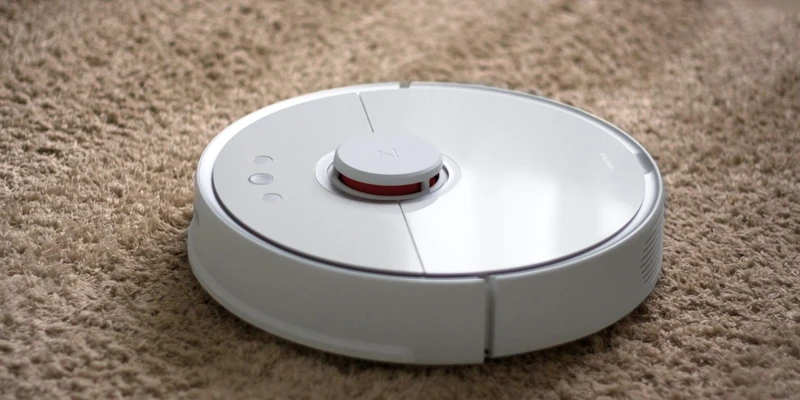
Smart vacuum cleaners have become increasingly popular due to their ability to navigate and clean a home autonomously. One of the key factors that sets smart vacuum cleaners apart from traditional vacuuming machines is the use of multiple types of sensors. These sensors work together to create a comprehensive map of the home and detect obstacles, allowing the vacuum cleaner to navigate around them and clean with precision.
Improved Navigation
The main advantage of using multiple types of sensors in smart vacuum cleaners is improved navigation. Traditional vacuum cleaners rely solely on human guidance, making navigation limited and sometimes frustrating. Smart vacuum cleaners, on the other hand, use a combination of sensors, including infrared, ultrasonic, and camera sensors, to create a map of the home and navigate accordingly. This allows them to clean more efficiently and thoroughly, without getting stuck or lost.
Efficient Cleaning
Another advantage of smart vacuum cleaners with multiple types of sensors is the ability to clean more effectively. For example, optical sensors can detect dirt and debris, allowing the vacuum cleaner to focus on heavily soiled areas. Tactile bump sensors help to avoid collisions and detect furniture, while cliff and obstacle sensors prevent the vacuum cleaner from falling downstairs or getting stuck on objects.
Extended Battery Life
Smart vacuum cleaners with multiple types of sensors are also more energy-efficient. This is because the sensors can help the vacuum cleaner to navigate and clean more efficiently, reducing the amount of time it needs to spend cleaning. This results in longer battery life, as the vacuum cleaner can clean larger spaces without needing to recharge.
Reduced Maintenance
Using multiple types of sensors in smart vacuum cleaners can also reduce the need for maintenance. For example, mapping sensors can help the vacuum cleaner to remember the layout of the home, reducing the likelihood of it getting stuck in the same place repeatedly. Acoustic sensors can detect mechanical issues before they become major problems, allowing for proactive maintenance.
Smart vacuum cleaners with multiple types of sensors offer a range of advantages over traditional vacuum cleaners. By improving navigation, cleaning efficiency, battery life, and reducing maintenance, these innovative devices are changing the way we clean our homes for the better. As sensor technology continues to evolve, we can expect to see even more advanced smart vacuum cleaners in the future.
The Future of Sensor Technology in Smart Vacuum Cleaners
As technology continues to advance, it’s no surprise that smart home devices are becoming more intelligent and sophisticated. This is certainly true of smart vacuum cleaners, which are now capable of navigating and cleaning a space with minimal human intervention. But what does the future hold for sensor technology in these devices?
One possibility is the integration of machine learning algorithms. This would allow the vacuum to learn from its cleaning patterns and adjust them accordingly, making it even more efficient at cleaning a space. As the vacuum becomes more intelligent, it could also learn to navigate more complex spaces and clean them with greater precision.
Another area of development is the use of LiDAR (Light Detection and Ranging) sensors. These sensors use lasers to create a detailed 3D map of a space, allowing the vacuum to navigate even more accurately and avoid obstacles with greater ease. LiDAR technology is already being used in autonomous vehicles, and it’s possible that we’ll see it being incorporated into smart vacuums in the future.
There’s also likely to be further refinement of existing sensors. For example, optical sensors may become even more accurate, allowing the vacuum to detect even the smallest debris on a floor. Additionally, the use of acoustic sensors could become more widespread, allowing the vacuum to detect sounds and alert the user to potential issues.
Finally, we may see the integration of smart home technology into these devices. As the Internet of Things (IoT) continues to expand, smart vacuums may be able to communicate with other devices in a home, such as smart thermostats or lighting systems. This would allow the vacuum to adapt its cleaning patterns based on the conditions in a home, for example, by reducing its noise level during a movie night.
The future of sensor technology in smart vacuum cleaners is exciting and promising. It’s likely that these devices will continue to become more intelligent and efficient, making them an increasingly valuable addition to our homes. As technology continues to evolve, we can expect to see even more innovative uses of sensors in these devices, making cleaning a space an even more effortless and enjoyable experience.
Conclusion
In conclusion, it is clear that sensors play a crucial role in the functionality of smart vacuum cleaners. They allow these devices to navigate through different types of environments, detect objects, and adjust the cleaning process to ensure maximum effectiveness.
The use of multiple types of sensors in smart vacuum cleaners offers numerous benefits, including improved performance, more accurate mapping, and better battery management. As technology advances, we can expect to see even more sophisticated sensors being developed that will further enhance the efficiency and functionality of smart vacuum cleaners.
Overall, investing in a smart vacuum cleaner with advanced sensor technology is a smart choice for those who want to simplify their cleaning routines and ensure that their homes are always clean and healthy. By selecting a model with the right combination of sensors, homeowners can enjoy a clean environment without the need for manual cleaning.
Frequently Asked Questions
What are smart vacuum cleaners?
Smart vacuum cleaners are robotic vacuum cleaners that are equipped with sensors and advanced technologies that enable them to clean floors without requiring much human intervention.
What are the types of sensors in smart vacuum cleaners?
The common types of sensors in smart vacuum cleaners include infrared sensors, ultrasonic sensors, optical sensors, tactile bump sensors, cliff and obstacle sensors, camera sensors, mapping sensors, acoustic sensors, and accelerometers and gyroscopes.
How do infrared sensors work in smart vacuum cleaners?
Infrared sensors in smart vacuum cleaners emit a beam of infrared light which bounces back when it detects an object. This enables the vacuum cleaner to perceive the location and distance of the object, allowing it to plan its cleaning path and avoid obstacles.
What are ultrasonic sensors in smart vacuum cleaners?
Ultrasonic sensors in smart vacuum cleaners use high-frequency sound waves to detect objects and obstacles. This allows the vacuum cleaner to create a detailed map of its environment and navigate around furniture and other obstacles.
What are optical sensors in smart vacuum cleaners?
Optical sensors in smart vacuum cleaners use cameras to create a visual map of its environment. This enables the vacuum cleaner to detect and avoid obstacles and plan an efficient cleaning path.
What are tactile bump sensors in smart vacuum cleaners?
Tactile bump sensors in smart vacuum cleaners use physical contact to detect obstacles. When the vacuum cleaner comes into contact with an object or obstacle, the sensors activate and prompt the vacuum to change its cleaning path.
How do cliff and obstacle sensors work in smart vacuum cleaners?
Cliff sensors in smart vacuum cleaners use infrared technology to detect edges and drops, such as stairs, so that the vacuum cleaner avoids falling over. The obstacle sensors detect nearby objects and prompt the vacuum to avoid them.
What are the advantages of smart vacuum cleaners with multiple types of sensors?
Smart vacuum cleaners with multiple types of sensors are more efficient, requiring less human intervention and ensuring thorough cleaning. They can also navigate complex environments and avoid obstacles with ease.
How can sensors in smart vacuum cleaners improve battery management?
Smart vacuum cleaners with battery management sensors can conserve energy by going into standby mode or returning to their charging station when their battery is running low. This ensures that the vacuum cleaner doesn’t run out of power mid-clean.
What is the future of sensor technology in smart vacuum cleaners?
The future of sensor technology in smart vacuum cleaners will likely involve even more advanced technologies, such as machine learning and artificial intelligence, allowing the vacuum cleaner to learn and adapt to its environment over time.
